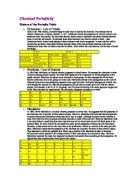Introduction:
Currently, there are 118 known elements. Of these, only 94 are believed to be occurring naturally on our planet. The remaining elements are either radioactive, fabricated as technology advanced or evolved with other elements as time passed by. A chemical element is defined as being pure material in its simplest form, a substance that cannot be broken down or separated any further. Every element has their unique properties that make up what they are. An element can only contain one type of atom, which is the amount of protons within the nucleus, this will always remain the same for the same type of element.
How are elements arranged:
The Periodic table is a display of all the elements that we know of, it is shaped like a rectangular box. The elements are sorted accordingly depending on their atomic structure, which shows their properties. They are arranged by increasing atomic number, which shows the amount of protons a certain element. Some elements have long names, that is why all elements are given an abbreviation which is shared throughout the scientific world. The atomic number could be found at the bottom left-hand corner of the abbreviation. The number which is at the top of the abbreviation is the mass number, this number is the sum of the amount of neutrons and protons. (E.g. If we want to find out the number of neutrons only, then we can find that out by using Mass number - Atomic Number).

This is a preview of the whole essay
Peer Reviews
Here's what a star student thought of this essay
Quality of writing
The fact that key words are in bold type is a very good skill to employ in any subject as it makes marks easy to find. The bibliography at the end of the essay is a good way for teacher/examiners to see where you got your information, to improve this a small evaluation of each source that includes comments on reliability, could be a good idea. Overall this is a very good essay because of the layout and use of key terms.
Level of analysis
The introduction gives a brief and concise overview, which includes a definition of what an element is which is key to understanding the rest of the essay. This is a transferable skill that you can use anywhere, which is explaining any key words that you use, it shows whoever is marking it that you have an in depth knowledge of the subject. The way the essay has been set out allows for very easy reading, as you do not have to go 'looking' for the points that could be worth marks. The language used for example 'valence electrons' is a high level term that is not commonly used until A-level. Maybe some of the terms used could have been better explained as it would had added to what is already a brilliant essay.
Response to question
The student answers the question well with the information given being accurate and relative to the subject. The response is explicit with everything a student at GCSE would need to learn about the periodic table.







